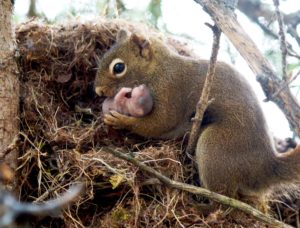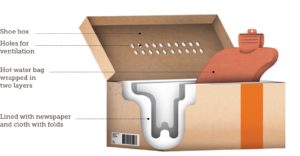BABY SQUIRREL(S)

Staying with their biological parent is their best chance of survival.
1. OBSERVE
Where did you find the baby?
If tree work was done recently, or there has been high winds or a storm, give the mother a chance to reclaim her babies as long as they are uninjured, warm and dry.
Leave the baby at the tree base during daylight hours and monitor them from a distance. Often when a tree was pruned or felled the mother runs off, but she will return later to reclaim her young if given the chance.

2. REUNITE
Is the baby in full view of mom?
The babies should be left out for the mother exactly where they were found or as close as possible to it. Don’t cover them with a blanket (mother won’t see them), and don’t put them in a deep box (mother won’t be able to access them). If a container is necessary, use a shallow shoe box (with flannel or fleece on the bottom).
This is the perfect opportunity to get out your smart phone and play this baby Grey squirrel distress call so momma squirrel comes running to the rescue! Be sure to wait at a safe distance so she can feel safe enough to retrieve the infant(s).
Is the baby in danger?
If free-roaming cats or dogs are around, the infant squirrel can be put in a wicker basket or similar device and the container attached securely to the tree trunk. The baby squirrel must remain within the immediate vicinity of where s/he fell, or the mother will not find him/her. Always wear gloves when handling wild babies. They can carry diseases and parasites and are also able to bite at a young age.
Is the baby cold?
If it is chilly outside, or if the babies are not fully furred and their eyes are not open, they will need a heat source, such as a hot water bottle or a chemical hand warmer covered in a thick sock. It’s important to ensure they stay warm because babies whose eyes aren’t open cannot thermo-regulate (control their own body temperature), and mammal mothers will not retrieve cold, sickly or compromised young.
If using a hot water bottle, make sure it can not roll over onto the baby(s) (use a T-shirt to prop it). The baby(s) needs to stay warm but must not overheat.

Be sure to give the mother an entire day to retrieve her young. It may take her that long to find or make a new nest.
Do not feed the baby!
Not only because they require a specialized diet but because you want their hungry cries to attract their mother. If they make crying sounds, use your cell phone to record them, then play the cries back on high volume. This is the best way to draw the mother in. She will respond to her babies’ cries. The recording will help her locate them.
If you did not have a full day to attempt a reunion, you can bring the babies inside overnight and attempt a reunion again the next morning, at sunrise. Get the babies out first thing in the morning, when the mother is likely to be looking and before she gives up.
Supervise the reunion from a distance. The mother will not return if she does not feel safe.
3. CALL
Call for help if:
If the baby is not retrieved by dark (mother squirrels stop being active after dusk) call for help.
If the baby is sick, injured or cold, the mom will not come back to retrieve him/her and compromise the health/safety of the rest of her babies.
While you wait:
Put the baby in a ventilated cardboard box lined with a soft fabric like flannel or fleece, and put a towel on top. Keep the baby in a quiet and dark location so they do not get stressed.
Human sounds such as TV, radio, voices, dogs barking, etc., can be harmful.
If a baby squirrel is active and almost adult-sized, and is following people and even trying to climb them, this behavior indicates a hungry juvenile who has lost his/her mother.
At this stage, they will run up to anything that moves. This animal needs to be taken to a wildlife rehabilitator for assistance.

